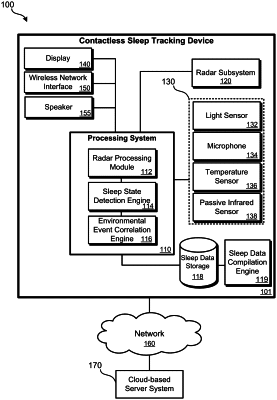| CPC G01S 13/62 (2013.01) [A61B 5/749 (2013.01); G01S 13/282 (2013.01)] | 20 Claims |

|
1. A contactless sleep tracking device, comprising:
a housing;
an electronic display screen housed by the housing;
a user interface housed by the housing;
a radar sensor housed by the housing; and
a processing system housed by the housing, comprising one or more processors, that receives data from the radar sensor and the user interface, and outputs data to the electronic display screen for presentation, wherein the processing system is configured to:
receive user input, via the user interface, that requests a sleep tracking setup process be performed;
in response to the user input, perform a detection process based on data received from the radar sensor to determine whether a user is present and static;
in response to the detection process determining that the user is present and static and prior to activating sleep tracking, perform a consistency analysis over a time period, wherein:
performing the consistency analysis comprises determining a duration of time of the time period that the user is present and static during the consistency analysis prior to activating sleep tracking,
during the consistency analysis and prior to activating sleep tracking, causing the electronic display screen to graphically indicate that calibration is being performed;
determining the duration of time exceeds a defined threshold amount of the time period; and
after the time period and based on determining the duration of time exceeds the defined threshold amount of the time period, activating sleep tracking such that when the user is detected in bed via the radar sensor, the user's sleep is tracked.
|